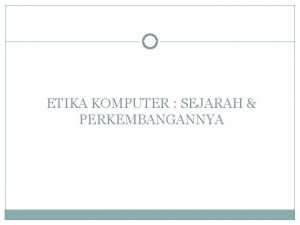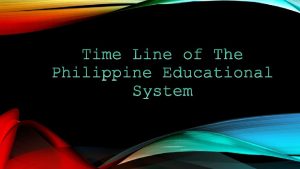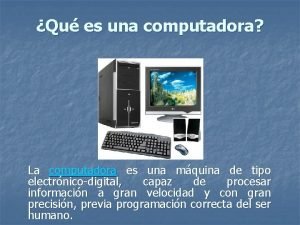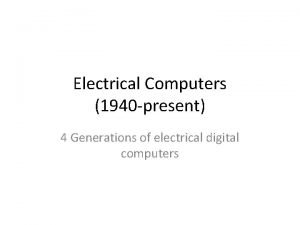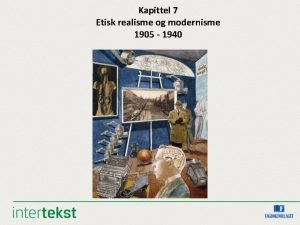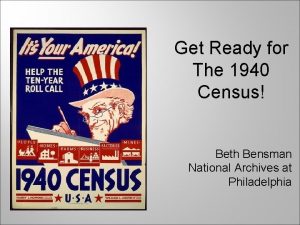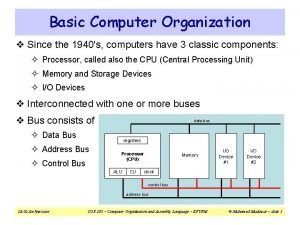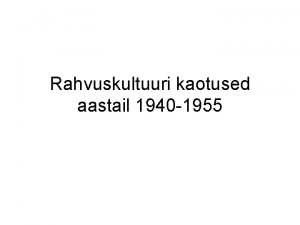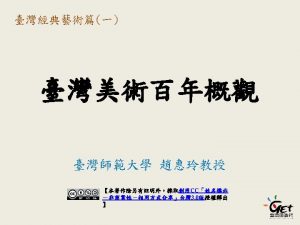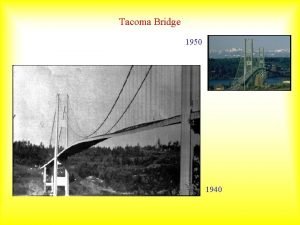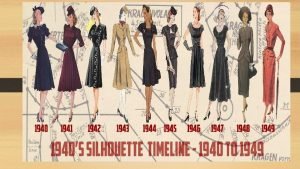American Education During the 1940 s and 1950

















- Slides: 17

American Education During the 1940 s and 1950 s By: Danielle Kang

First Public Schools Boston , Massachusetts 1827 • Massachusetts passes a law making all grades of public school open to all children for free of charge.

The First Normal School 1819 -1830 • On July 3, 1839, three young women reported to Lexington, Massachusetts, with hopes of attending the first state funded school specifically established for public teacher education (what were then referred to as "normal" schools). After taking an examination which determined they were satisfactorily versed in the subjects taught by the ordinary district school, they were granted admission to this experimental program, the first in the nation. • For the upper classes there existed some good colleges providing a classical education for ministry, law or medicine. Teacher education was not considered a profession worthy of their attentions. Common (public) schools at this point were in bad shape. Typically in session only four months of the year (because of the agrarian society and the need to have children helping out at home), they were poorly attended, and basically taught by whomever was available. Pay of $30. 00 per month was not much of a motivator for teachers to seek out an education specific to the occupation or for existing colleges to provide it.

First Latin School 1635 • The Boston Latin School is a public "exam school" in Boston, Massachusetts. Established on April 23, 1635, it is both the oldest school and the first public school in the United States. [2][3][4][5] The Public Latin School was a bastion for educating the sons of the Boston "Brahmin" elite, resulting in the School claiming many prominent Bostonians, Massachusetts citizens and New Englanders as alumni. Its curriculum follows that of the 18 th century Latin-school movement, which holds the "classics" to be the basis of an educated mind.

Cumming v. Richmond County Board of Education 1899 -1954 • The plaintiffs, "Cumming, Harper and Ladeveze, citizens of Georgia and persons of color suing on behalf of themselves and all others in like case joining with them, " originally filed suit by petition against the "Board of Education of Richmond County" (the "Board") and one "Charles S. Bohler, tax collector" in the Superior Court of Richmond County, claiming among other causes of action, that a $45, 000 tax levied against the county for primary, intermediate, grammar and high schools was illegal insofar as the high schools of the county were exclusively for white students, and seeking an injunction barring the collection of so much of the total amount as was earmarked for the white only high school system. • County was reversed upon the ground that it erred in granting an injunction against the Board of Education. In accordance with that decision, the Superior Court upon the return of the cause from the Supreme Court of the State, refused the relief asked by the plaintiffs and dismissed their petition. Thereafter, the plaintiffs appealed that order to the United States Supreme Court as being in derogation of their rights under the Constitution of the United States. The Supreme Court affirmed.

Court Cases

Ingraham V. S. Wright 1976 -1977 • Ingram vs Wright was about when the principle of this peculiar school when they were allowed to paddle if any student were misbehaving for appropriate time. • At that time when a student is misbehaving they get paddled for their immaturity but not with this principle because Principle Wright caught a student name James Ingraham who is a 13 year old that went to Charles j. Drew Junior High were paddled more than 20 time over the limit so in October the year of 1970

Plessy V. S Ferguson 1890 -1892 • Plessy v. Ferguson, 163 U. S. 537 (1896), was a landmark United States Supreme Court decision upholding the constitutionality of state laws requiring racial segregation in public facilities under the doctrine of " separate but equal ". • Plessy v. Ferguson, case in which the U. S. Supreme Court, on May 18, 1896, by a seven-to- one majority (one justice did not participate), advanced the controversial “separate but equal” doctrine for assessing the constitutionality of racial segregation laws. Plessy v. Ferguson was the first major inquiry into the meaning of the Fourteenth Amendment’s (1868) equal-protection clause, which prohibits the states from denying “equal protection of the laws” to any person within their jurisdictions.

Brown V. S Board of Education 1952 -1954 • This case was the consolidation of four cases arising in separate states relating to the segregation of public schools on the basis of race. In each of the cases, African American minors had been denied admittance to certain public schools based on laws allowing public education to be segregated by race. They argued that such segregation violates the Equal Protection Clause of the Fourteenth Amendment. The plaintiffs were denied relief based on the precedent set by Plessy v. Ferguson, which established the “separate but equal” doctrine that stated separate facilities for the races was constitutional as long as the facilities were “substantially equal. ” In the case arising from Delaware, the Supreme Court of Delaware ruled that the African American students had to be admitted to the white public schools because of their higher quality facilities.

Vocational Rehabilitation Act

Vocational Rehabilitation Act • The Vocational Rehabilitation Act of 1973 Title V, was put in place to correct the problem of discrimination against people with disabilities in the United States. Affirmative action programs were established in Title V, Sections 501, 502, 503, and 504. Individuals who qualify as having a disability have experienced discrimination both because of negative attitudes in regards to their ability to be an effective employee, as well as the physical barriers at work facilities. The Title V of the Vocational Rehabilitation Act requires private employers with federal contracts over $2, 500 to take affirmative action to hire individuals with a mental or physical disability. While this means that employers must make reasonable accommodations for disabled employees, it does not mean they must hire unqualified individuals. There additional sections of the Act that provide vocational counseling, training assistance and job placement for individuals with severe disabilities

Desgregation

Desegregation 1960 -1964 • Desegregation was long a focus of the American Civil Rights Movement, both before and after the United States Supreme Court's decision in Brown v. Board of Education, particularly desegregation of the school systems and the military. • Partially this was inform to the African American.

Title IX

Title XI 1972 -1979 • The U. S. Department of Education’s Office for Civil Rights (OCR) enforces, among other statutes, Title IX of the Education Amendments of 1972. Title IX protects people from discrimination based on sex in education programs or activities that receive Federal financial assistance. Title IX states that: • No person in the United States shall, on the basis of sex, be excluded from participation in, be denied the benefits of, or be subjected to discrimination under any education program or activity receiving Federal financial assistance.

No Child Left Behind

No Child Left Behind • The No Child Left Behind law—the 2002 update of the Elementary and Secondary Education Act— effectively scaled up the federal role in holding schools accountable for student outcomes. • It was the product of a collaboration between civil rights and business groups, as well as both Democrats and Republicans on Capitol Hill and the Bush administration, which sought to advance American competitiveness and close the achievement gap between poor and minority students and their more advantaged peers. Since 2002, it’s had an outsized impact on teaching, learning, and school improvement—and become increasingly controversial with educators and the general public
 Pengertian etika komputer
Pengertian etika komputer Executive order no. 134 of 1936
Executive order no. 134 of 1936 What is philippine opera
What is philippine opera Self portrait with monkey 1940
Self portrait with monkey 1940 Computador de 1940
Computador de 1940 1940 lahore prostab
1940 lahore prostab Edvac full form
Edvac full form Japanese empire 1940
Japanese empire 1940 Tiub hampagas
Tiub hampagas Baltic states 1940
Baltic states 1940 Modernisme literatuur
Modernisme literatuur Regla de erwin chargaff 1940
Regla de erwin chargaff 1940 Suomen olympialaiset 1940
Suomen olympialaiset 1940 Edhint
Edhint Komputer generasi pertama
Komputer generasi pertama Computers since 1940s
Computers since 1940s Lpetati
Lpetati 1930-1939 fashion
1930-1939 fashion
